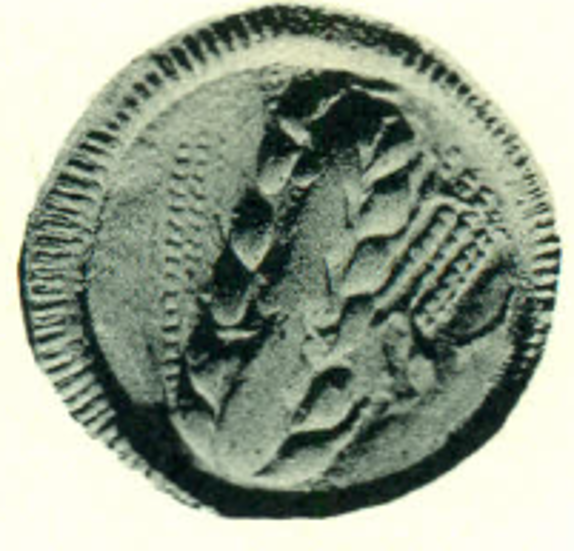1943 - Metapontum (nomos ear of barley/ear of barley) over Corinth (Pegasus/incuse square) (Charles Hersch coll. - Noe 1957, pl. VI, c): Difference between revisions
From SILVER
No edit summary |
No edit summary |
||
| Line 9: | Line 9: | ||
|Mint=Metapontum | |Mint=Metapontum | ||
|Ancient region=Magna Graecia (Lucania) | |Ancient region=Magna Graecia (Lucania) | ||
|Date from=540 BCE | |||
|Date to=510 BCE | |||
|Period=Archaic | |||
|Metal=Silver | |||
|Denomination=stater / tridrachm / nomos | |Denomination=stater / tridrachm / nomos | ||
|Standard=Achaian | |Standard=Achaian | ||
|Coin reference=Noe 1957, p. 13-42, pl. V-XIV (group II, p. 21, pl. VI, c). | |Coin reference=Noe 1957, p. 13-42, pl. V-XIV (group II, p. 21, pl. VI, c). | ||
|Coin series reference=HN Italy, no° 1459, 1463, 1465, 1467, 1470, 1472, 1474, 1479, 1481-1486.; HGC 1, n° 1027-1029 | |Coin series reference=HN Italy, no° 1459, 1463, 1465, 1467, 1470, 1472, 1474, 1479, 1481-1486.; HGC 1, n° 1027-1029 | ||
|Coin series web reference=https://greekcoinage.org/iris/id/metapontum.hn_italy.1459-81 | |||
|Overstruck obverse description=Pegasus. | |Overstruck obverse description=Pegasus. | ||
|Overstruck reverse description=Swastika. | |Overstruck reverse description=Swastika. | ||
Revision as of 14:37, 6 June 2023
540 BCE - 510 BCEMETA
Location/history
| Museum collectionMuseum collection: | New York, American Numismatic Society | |
| Private collection(s)Private collection(s) ᵖ: | C. Hersch collection |
Overstriking coin
Description
| ObverseInscription or printing placed on the obverse.: | META (Greek) Ear of cereal. Decorated border. | ReverseInscription or printing placed on the reverse.: | Ear of grain. Border of rays (incuse). |
Mint and issuing power
| MintIdentifies the place of manufacture or issue of a numismatic object.: | Metapontum | Ancient regionAncient region. | Magna Graecia (Lucania) | Modern countryModern country: Italy | AuthorityIdentifies the issuing power. The authority can be "pretended" when the name or the portrait of X is on the coin but he/she was not the issuing power. It can also be "uncertain" when there is no mention of X on the coin but he/she was the issuing power according to the historical sources: |
Chronology
| FromIdentifies the initial date in a range assigned in a numismatic context. 540 BCE toIdentifies the final date in a range assigned in a numismatic context.. 510 BCE | Archaic until 480 BC |
Physical description
| MetalThe physical material (usually metal) from which an object is made.: Silver |
DenominationTerm indicating the value of a numismatic object. Examples: tetradrachm, chalkous, denarius.: stater / tridrachm / nomos | ||
| StandardStandard.: Achaian | |||
References
| Coin referenceReference of the Coin: | Noe 1957, p. 13-42, pl. V-XIV (group II, p. 21, pl. VI, c). | Coin series referenceReference to coin series study: | HN Italy1HN Italy, no° 1459, 1463, 1465, 1467, 1470, 1472, 1474, 1479, 1481-1486., HGC 12HGC 1, n° 1027-1029 |
| Coin series web referenceCoin series web references: | |||
Overstruck type
Description
| ObverseInscription or printing placed on the obverse.: | Pegasus. | ReverseInscription or printing placed on the reverse.: | Swastika. |
Mint and issuing power
| MintIdentifies the place of manufacture or issue of a numismatic object. ᵖ: | Corinth | Ancient regionAncient region. ᵖ | Peloponnesus | Modern countryModern country: Greece | AuthorityIdentifies the authority in whose name (explicitly or implicitly) a numismatic object was issued. ᵖ: |
Chronology
| FromIdentifies the initial date in a range assigned in a numismatic context. toIdentifies the final date in a range assigned in a numismatic context.. | periodTime period of the numismatic object. |
Physical description
References
| Coin type referenceReference to coin series study ᵖ: |
Additional data
| Frequency of overstrikesFrequency of overstrikes: | Level of confidenceLevel of confidence of the identification: | ||
| RemarksRemarks: | |||
